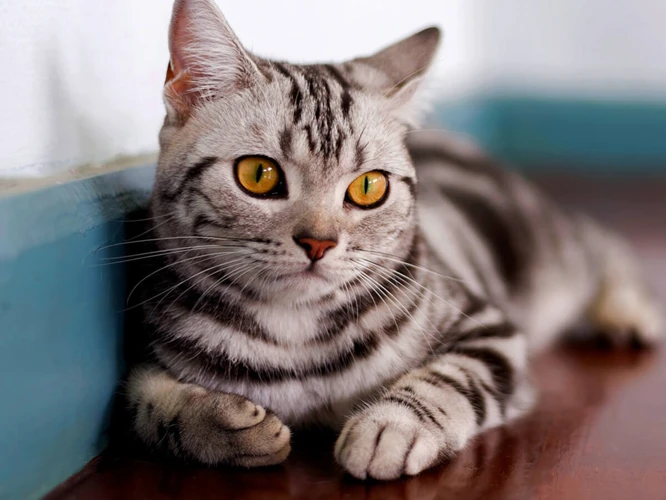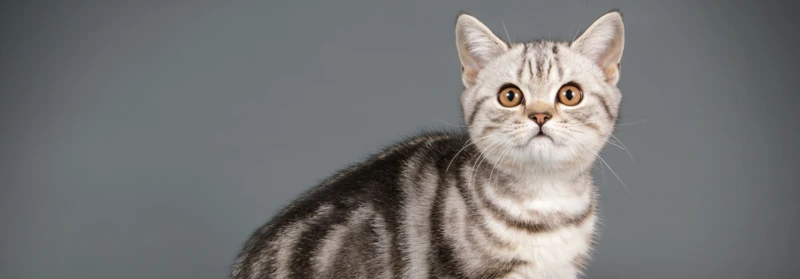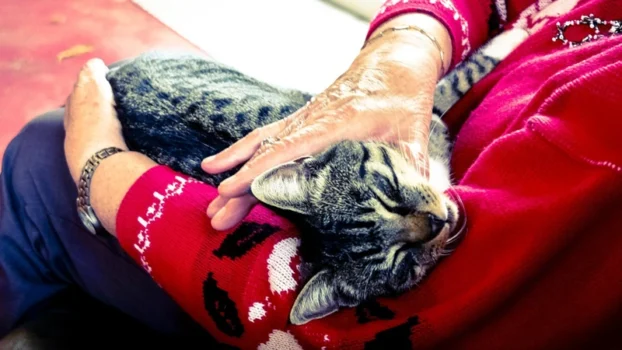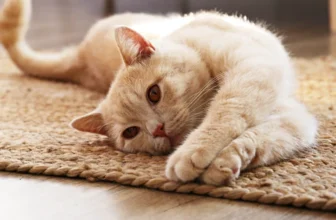As our feline friends age, they may experience a decline in their mobility which can affect their overall wellbeing and quality of life. This is especially true for senior American Shorthair cats who may be more prone to developing age-related joint and muscle conditions. However, with the right care and attention, it’s possible to help maintain their mobility and keep them active and happy for years to come. In this article, we’ll explore a variety of exercises and tips to help senior American Shorthair cats stay mobile and healthy.
Importance of Maintaining Mobility in Senior American Shorthair Cat

As your American Shorthair cat grows older, it is essential to pay extra attention to their mobility. Just like humans, senior cats also experience wear and tear in their joints, which can lead to mobility issues. Maintaining mobility in senior cats is critical for their overall well-being as it helps prevent further health issues. In this part of the article, we will discuss the importance of maintaining mobility in senior American Shorthair cats and how exercises can play a crucial role in achieving this. For more tips on senior American Shorthair cat care, check out our useful guide.
Understanding Mobility Issues in Senior Cats
Mobility issues in senior American Shorthair cats are common, and they may face difficulty moving around as they age. Senior cats experience the onset of joint issues such as arthritis, which makes it painful for them to move around. Along with arthritis, other problems like obesity, weakened muscles, and decreased energy levels can add to the mobility issues.
Arthritis: This is the most common mobility issue in senior cats, and it can affect any joint in cats. Arthritis causes inflammation, painful swelling, and stiffness in the joints. This can make it more difficult for cats to jump or climb, and they may experience difficulty in performing routine tasks like using the litter box.
Obesity: Overweight cats may experience difficulty in moving due to the extra weight. This can put added pressure on their joints and may cause stiffness or muscle weakness. It can also lead to other health problems, such as diabetes, that can further reduce mobility.
Muscle Weakness: As cats age, their muscles may weaken, making it harder for them to maintain their balance and move.
Decreased Energy Levels: Senior cats may experience decreased energy levels, leading to reduced activity levels. This can increase mobility issues in cats as they tend to avoid movement.
To help your senior American Shorthair cat maintain mobility, it is important to understand these issues in more detail. Along with exercises, proper nutrition, and litter box placement, it is essential to monitor your cat’s mobility issues. Regular check-ups with a veterinarian will help you diagnose and treat any underlying health issues that may be impacting your cat’s mobility. Additionally, a senior cat who has already experienced a decline in mobility can benefit from holistic treatments such as massage therapy, acupuncture, and chiropractic care. If you want to learn more about preventive healthcare tips for your senior American Shorthair cat, you can read our article on preventive health for senior American Shorthair cats.
Benefits of Maintaining Mobility in Senior Cats
Maintaining mobility is crucial for senior American Shorthair cats as it brings multiple benefits for their overall well-being. Here are some benefits of keeping your cat active:
- Preventing obesity: Senior cats are prone to becoming overweight, which can lead to further health issues. Exercise helps in burning calories and maintaining a healthy weight.
- Lowering the risk of joint stiffness and pain: Regular movement keeps joints flexible and reduces the risk of developing arthritis or other joint problems.
- Improving cardiovascular health: Physical activity increases blood flow and strengthens the heart, thus reducing the risk of heart diseases.
- Stimulating mental health: Exercise releases endorphins, which act as mood-boosters, thus reducing stress and anxiety levels in cats.
- Increasing social interaction: Engaging in interactive exercises with your cat can significantly improve the bond between pet and owner and increase social interaction with other pets, if any.
All these benefits make exercising an essential part of senior American Shorthair cat’s routine, which, when combined with a healthy diet like best diets for senior American Shorthair cats and providing a comfortable litter box, can help them enjoy their golden years with excellent health and vitality.
Exercises to Maintain Mobility

As our furry friends age, their mobility may become limited due to various factors such as arthritis, muscle weakness, or joint pain. However, just like in humans, regular exercise can help maintain and improve the mobility of senior cats. In this section, we’ll discuss six types of exercises that can be done at home to help keep your senior American Shorthair cat active and mobile. These exercises are designed to be gentle on their joints and muscles, yet effective in promoting flexibility, balance, strength, and aerobic conditioning.
Stretching Exercises
Stretching exercises are an essential part of maintaining mobility in senior American Shorthair cats. Regular stretching can help to keep your furry friend’s muscles and joints flexible, which enhances their overall range of motion. Here are some stretching exercises that you can perform to help keep your senior cat limber and agile:
| Stretching Exercise | Instructions |
|---|---|
| Neck Stretches | With your cat in a sitting position, gently tilt their head to the right until you feel a stretch in their neck muscles. Hold for a few seconds and repeat on the left side. You can also perform this stretch by gently massaging your cat’s neck muscles. |
| Leg Stretches | Gently tap the top of your cat’s paw to get them to extend their leg. Then, gently pull their leg back towards their body until you feel a stretch in their hip and thigh muscles. Hold for a few seconds and repeat on the other side. |
| Back Stretches | With your cat in a sitting position, place one hand on their chest and the other hand on their back near their tail. Gently press down on their back until you feel a stretch in their spine. Hold for a few seconds and release. |
| Tail Stretches | Gently hold your cat’s tail at the base and gently pull it towards their head until you feel a slight stretch in their tail muscles. Hold for a few seconds and release. |
Perform these stretching exercises once a day, and your senior American Shorthair cat will become more relaxed, flexible, and less prone to stiffness or injury. Remember, if your cat seems uncomfortable or shows any signs of pain during the stretching exercises, then discontinue or adjust them accordingly.
Joint Flexibility Exercises
Helping your senior American Shorthair cat maintain joint flexibility is important for their overall mobility and comfort. Joint flexibility exercises will help reduce stiffness and improve your cat’s range of motion. Here are some exercises you can do with your cat to improve joint flexibility:
| Exercise | Description |
|---|---|
| Gentle Massage | Start by gently massaging the muscles around your cat’s joints to warm them up. Then, gently stretch and wiggle each joint, taking care to not force any movements that may cause pain. |
| Passive Range of Motion | Hold your cat’s limb and move it through its full range of motion, gently stretching the joint. |
| Assisted Range of Motion | Assist your cat in performing the same passive range of motion exercises by gently stretching his joint extended in normal direction and then back to the initial position. |
| Stair Climbing | Encourage your cat to climb up and down stairs to use their joints and improve their flexibility. Start with a small staircase and gradually increase the number of stairs as your cat gets more comfortable. |
Keep in mind that while joint flexibility exercises are beneficial, it’s important to not push your senior cat too hard. Start with shorter sessions and gradually increase the amount of time and intensity as your cat becomes more comfortable. Always monitor your cat’s response and speak with your vet regarding any concerns.
Balancing Exercises
Maintaining balance is crucial for senior American Shorthair cats as it helps to prevent falls and injuries that can severely impact their mobility. Here are some balancing exercises that can help your furry friend maintain their balance:
- Balance Beam: Use a low beam or a piece of wood to create a balance beam and encourage your cat to walk across it. Begin with a shorter distance and gradually increase it over time.
- Unstable Surface: Encourage your cat to stand or sit on an unstable surface such as a therapy ball to improve their balance and core strength. Start with a large ball that is more stable and gradually move to smaller ones.
- Target Training: Hold a target in front of your cat and encourage them to reach for it while standing on their hind legs. This exercise helps build leg strength and improves balance.
- Hind Leg Stand: Gently hold your cat’s front paws while encouraging them to stand on their hind legs. This exercise helps improve balance and strengthens hind leg muscles.
It is important to supervise your cat during balancing exercises, especially if they are new to the movement. Start with short sessions and provide plenty of rewards and positive reinforcement to encourage your cat to participate. Remember to consult with your veterinarian and assess your cat’s overall health before starting any new exercise routine.
Strength Training Exercises
As your American Shorthair cat grows old, their muscles may become naturally weaker and they may start losing their strength. Regular strength training exercises can help your senior cat maintain their muscle mass and keep them strong. Here are some exercises you can incorporate into your cat’s routine:
- Scratching Posts: Encourage your cat to use a scratching post to climb up and down. This exercise helps to build their upper body and leg muscles.
- Laser Pointers: Use a laser pointer to have your cat chase the light around the room. This exercise activity helps in building their leg muscles and keeping them active.
- Toy Play: Playing with toys such as a feather wand will encourage your cat to jump and pounce, building their lower body strength.
- Weighted Arm Lifts: You can get small weights that can be wrapped in a towel and tied to your cat’s paw. This exercise is good for building bicep and tricep muscles.
- Food Dispenser: Slow feeders and food dispensers are a great way to keep your cat engaged and active and these are good strengthening exercises for their neck and jaw muscles.
It is important to keep in mind that just like with any other exercise, your senior cat may not be able to lift heavy weights. Start with light weights and ensure that your cat is comfortable with the exercise before increasing the weight. You can also consult your vet for advice on the appropriate weight and the best exercises to suit your cat’s needs.
Incorporating a strength training routine into your senior cat’s exercise program can help to maintain their muscle strength and prevent muscle strain or injury. Keep in mind that your cat’s motivation and comfort level should be taken into consideration during these exercises. By gradually increasing the difficulty level, your cat will gain the strength and endurance they need to stay healthy and happy.
Aerobic Exercises
Aerobic exercises are essential for maintaining the cardiovascular health of senior American Shorthair cats. These exercises improve their breathing and blood circulation, making them feel more energetic and active. Here are some great aerobic exercises that you can try with your feline friend:
| Exercise | Description |
|---|---|
| Chasing Toy | Cats love chasing toys, and it’s a fun way to get them moving. Use toys that encourage jumping and running, like a feather wand or laser pointer. Make sure that the toys are safe and non-toxic. |
| Playing with Catnip Toys | Catnip toys can stimulate cats and encourage them to play. These toys can also be used as a reward after a workout session. Make sure to use high-quality catnip toys that are durable and non-toxic. |
| Stair Climbing | If your cat can handle it, you can encourage them to climb stairs. This exercise is great for building endurance and strengthening their leg muscles. Make sure to supervise your cat while they climb to avoid any accidents. |
| Running on a Treadmill | Treadmill exercises are great for cats who can’t go outside or have limited mobility. Start slowly and gradually increase the speed and duration of the exercise. Make sure to use a treadmill that is safe and appropriate for cats. |
It’s important to remember that not all cats are the same, and their exercise needs may vary. Always monitor your cat’s response to aerobic exercises and adjust accordingly. Don’t push them too hard or cause any discomfort. Aerobic exercises should be a fun and enjoyable experience for both you and your cat.
Hydrotherapy
One great way to keep your senior American Shorthair cat’s mobility levels up is through the use of hydrotherapy. Hydrotherapy is a type of physical exercise that involves the use of water to help improve a cat’s mobility.
How hydrotherapy works
Hydrotherapy works by providing buoyancy and support to the cat, while at the same time reducing the amount of pressure on their joints and muscles. The water also provides resistance, which can help to strengthen a cat’s muscles and improve their overall range of motion.
The benefits of hydrotherapy
Hydrotherapy has a number of potential benefits for senior cats, including improved joint mobility and flexibility, increased muscle strength, improved cardiovascular health, and reduced pain and inflammation.
How to perform hydrotherapy on your senior cat
To perform hydrotherapy on your senior cat, you will need to start by filling a shallow pool or bathtub with warm water. Make sure that the water is not too hot or too cold, as this can be uncomfortable or even harmful for your cat.
Hydrotherapy table
| Step | Actions |
|---|---|
| 1 | Guide your cat into the water, holding them gently under their belly for support. Start with just a few minutes at a time and gradually build up to longer sessions as your cat becomes more comfortable. |
| 2 | Encourage your cat to move around in the water by gently waving a toy or treat in front of them. Use positive reinforcement to help them associate the water with something enjoyable. |
| 3 | Gradually increase the intensity of the exercise by increasing the depth of the water, adding resistance with specially designed hydrotherapy equipment or by varying the speed of the water flow. |
| 4 | Following each hydrotherapy session, dry your cat thoroughly with a towel and make sure they are warm and comfortable. |
Conclusion
Hydrotherapy can be a highly effective way to help maintain mobility in senior American Shorthair cats. If you’re considering using hydrotherapy as a form of exercise for your cat, always consult with your veterinarian first to ensure it is a safe and suitable option for your feline friend.
Tips to Keep in Mind
As pet parents, it is important to ensure that our senior American Shorthair cats are receiving the care and attention they need to maintain their health and well-being. In addition to exercise, there are other important tips to keep in mind when it comes to maintaining the mobility of your feline friend. By implementing these tips, you can help your senior cat stay active, healthy, and happy for as long as possible. Let’s dive into some key things to keep in mind.
Consult Your Vet
Before starting any exercise program for your senior American Shorthair cat, it is important to consult your vet. Your vet will be able to assess your cat’s health condition and determine which exercises are safe and appropriate for your pet. It is crucial to follow your vet’s recommendations to prevent any potential injury or harm to your cat.
Why Consult Your Vet?
Consulting your vet before starting any exercise program for your cat is essential for several reasons:
| Reasons | Explanation |
|---|---|
| Age and Comorbidities | Senior cats may have underlying health issues, such as arthritis, that require special care. Your vet will be able to provide insight on what exercises are suitable for your specific cat’s needs. |
| Injury History | If your cat has had previous injuries or surgeries, certain exercises may not be suitable or may require modifications to prevent further injury or discomfort. |
| Overall Health Condition | Your vet will check your cat’s overall health condition, such as weight, blood pressure, and heart rate to determine if your cat is healthy enough to perform exercises. They can also suggest any necessary dietary changes or supplements that may improve your cat’s mobility. |
| Expert Advice | Consulting your vet ensures that you receive expert advice on how to maintain your cat’s mobility safely and effectively. They can provide you with specific exercise recommendations tailored towards your cat’s individual needs. |
Conclusion
Consulting your vet is an important step in ensuring your senior American Shorthair cat stays healthy and mobile. They can offer valuable information on his or her health condition and provide tailored exercise recommendations that will help strengthen your cat’s muscles and joints. Remember to consult with your vet regularly to ensure that your cat maintains an active and healthy lifestyle.
Start Slowly
It’s important to take things slow when starting an exercise program for your senior American Shorthair cat. Just like humans, cats may need time to adjust and build up their strength. Here are some tips to help get started:
| Tip #1: | Start with easy exercises that your cat is familiar with and enjoys. This will help build confidence and prevent any fear or anxiety. |
| Tip #2: | Gradually increase the intensity and duration of the exercises to prevent injury or exhaustion. Start with just a few minutes a day and increase over time. |
| Tip #3: | Observe your cat’s behavior during and after exercise. If they seem fatigued or in pain, adjust the routine accordingly. |
| Tip #4: | Consider your cat’s overall health when developing an exercise plan. If they have any underlying medical conditions, some exercises may not be appropriate for them. |
By taking things slowly, you can help your senior American Shorthair cat maintain mobility and improve their overall health and well-being without causing unnecessary stress or discomfort. Remember to consult with your veterinarian before starting any exercise program, and to always monitor your cat’s response to the exercises.
Make Sessions Short and Frequent
To make the exercise routine effective, it is important to keep in mind the duration and frequency of the sessions. If your senior American Shorthair cat has limited mobility, then overexertion can cause more harm than good. It is essential to keep the sessions short and frequent.
Short Sessions: Instead of having a prolonged exercise session, it is recommended to divide the exercises into shorter sessions. Cats have a limited attention span, and they may lose interest in the activity quickly. It is crucial to keep the session short, so that the cat stays motivated and engaged. A duration of 10-15 minutes per session is ideal, and it can be increased gradually.
Frequent Sessions: To improve mobility, consistency is the key. Exercise sessions should be scheduled daily or on alternate days depending on the cat’s capability. In this way, the cat’s joints and muscles will get a regular workout, leading to increased strength and flexibility. It not only helps to maintain mobility but also acts as a preventive measure against joint-related health issues.
The following table provides a summary of the recommended duration and frequency of exercise sessions for senior American Shorthair cats:
| Session duration | Frequency per week |
|---|---|
| 10-15 minutes | 3-4 times a week |
Keeping the sessions short and frequent is an essential factor in maintaining mobility in senior American Shorthair cats. By adhering to this schedule, you can ensure that your cat receives the maximum benefit from exercise without causing any harm. Make sure to monitor your cat’s response, as incorporating a daily routine that involves exercise can take some getting used to.
Use Treats and Positive Reinforcements
One of the most effective ways to motivate your senior American Shorthair cat to participate in mobility exercises is to use treats and positive reinforcements. By using positive reinforcement, you are rewarding your cat when they move correctly or complete a set of exercises. This will help to increase their motivation to exercise and make it an enjoyable experience for them.
To get started, choose a treat that your cat loves and is willing to work for. It could be a piece of chicken, tuna, or even a small catnip toy. During the exercise session, offer your cat a treat when they complete a set of exercises correctly or make an effort to participate. This helps to encourage them and will make them remember the experience positively.
It’s important to note that you should not offer treats too frequently as it can lead to overeating and weight gain. Instead, offer treats sparingly and use verbal praise to reward your cat in between. This could be as simple as saying “good job” or “well done” when your cat completes a set of exercises.
Another way to incorporate positive reinforcement is to use toys that encourage movement and play. This could be a feather wand or a toy that your cat can chase and pounce on. By making the exercise session fun, your cat will be more motivated to participate and will look forward to future sessions.
Using treats and positive reinforcement can be an effective way to encourage your senior American Shorthair cat to participate in mobility exercises. Just remember to use treats sparingly, offer verbal praise, and make exercise sessions fun with toys and playtime.
Monitor Your Cat’s Response
It is highly important to constantly monitor your senior American Shorthair cat’s response during exercise sessions. Here are some tips to help you observe their behavior and reactions:
- Observe their body language: Watch for signs of discomfort or pain, such as panting, trembling, or limping. Cats may also vocalize or display aggressive behavior if they are in distress.
- Check their breathing: Make sure your cat is not breathing abnormally or struggling to catch their breath. This could indicate an underlying health issue that needs to be addressed.
- Track their progress: Keep a record of your cat’s progress and the exercises they are able to do. This will help you adjust their routine and prevent any further mobility issues.
- Modify exercises if necessary: If your cat is struggling with a certain exercise or seems to be in discomfort, modify the exercise to make it easier or skip it altogether.
- Stop the session if needed: If your cat shows signs of exhaustion or pain, stop the session immediately and consult with your vet if necessary.
By monitoring your senior cat’s response and adjusting their routine accordingly, you can help maintain their mobility and ensure their overall health and well-being.
Choose Right Time
Choosing the right time to exercise with your senior American Shorthair cat is equally important as choosing the right exercise routine. The right time ensures that your cat is not fatigued, agitated, or uninterested in the activity. Planning the right time also helps to reduce the risk of injuries and overexertion.
The table below outlines some of the key factors to consider when choosing the right time to exercise with your cat.
| Factor | Considerations |
|---|---|
| Cat’s energy levels | Observe your cat’s behavior and choose a time when they are most active and alert. This could be in the mornings or early evenings. |
| Meal times | Avoid exercising your cat immediately after meal times. Allow at least an hour to pass before beginning the exercise session. |
| Weather conditions | Ensure the exercise environment is conducive for you and your cat. Avoid extremely hot or cold conditions. |
| Cat’s mood | Choose a time when your cat is relaxed and calm. Avoid exercising if they are agitated or exhibiting stress signals. |
| Exercise intensity | Choose a time when you can devote adequate time to cater to the exercise needs of your cat. Avoid rushing through the exercise or overexerting them. |
By considering the above factors, you can plan and choose the right time to exercise with your senior American Shorthair cat. Remember to monitor your cat’s behavior during the exercise session and make adjustments as necessary.
Conclusion
Maintaining mobility in senior American Shorthair cats is essential for their overall health and well-being. Through various exercises, owners can help their cats continue to enjoy a good quality of life and prevent the onset of mobility issues.
Remember to always consult with your vet before starting any exercise program with your cat, as they can provide insight and guidance specific to your cat’s needs. Take it slow when introducing new exercises and make sessions short and frequent to build up your cat’s stamina and strength. Use treats and positive reinforcement to encourage your cat and monitor their response closely to ensure they are not experiencing any pain or discomfort.
Incorporating exercises into your senior cat’s routine is a great way to spend quality time together and also provides mental stimulation. By incorporating stretching, joint flexibility, balancing, strength training, and aerobic exercises, your cat can maintain their mobility for years to come. Additionally, hydrotherapy can be a helpful tool in managing mobility issues in senior cats.
Regular exercise and mobility maintenance are key to ensuring that your senior American Shorthair cat lives a happy and healthy life. Take the time to incorporate these exercises into your cat’s routine and watch as they continue to thrive in their golden years.
Frequently Asked Questions
Can senior American Shorthair cats benefit from exercising?
Yes, senior American Shorthair cats can benefit greatly from exercising. Regular exercise helps maintain their physical and mental health, and can also prevent and alleviate many mobility issues that arise with age.
What are some common mobility issues in senior cats?
Some common mobility issues in senior cats include arthritis, joint stiffness, muscle weakness, reduced flexibility, and balance problems.
What are some benefits of maintaining mobility in senior cats?
Maintaining mobility in senior cats can improve their overall quality of life. It can help prevent obesity, improve circulation and digestion, reduce stress and anxiety, and prevent or manage many health conditions.
Do I need to consult with my veterinarian before starting an exercise routine with my cat?
Yes, it is always best to consult with your veterinarian before starting an exercise routine with your cat. They can help you determine the most appropriate exercises based on your cat’s individual needs and health status.
How often should I exercise my senior American Shorthair cat?
You should aim to exercise your senior American Shorthair cat for at least 15-30 minutes per day, ideally in short, frequent sessions.
What are some stretching exercises that can benefit senior cats?
Stretching exercises such as neck stretches, spine stretches, and leg stretches can help improve flexibility and range of motion in senior cats.
What are some balancing exercises that can benefit senior cats?
Exercises such as stepping over objects, walking on uneven surfaces, and standing on hind legs can help improve balance and coordination in senior cats.
What are some strength training exercises that can benefit senior cats?
Strength training exercises such as wall sits, gentle weightlifting, and resistance band exercises can help improve muscle tone and maintain or increase muscle mass in senior cats.
What is hydrotherapy and how can it benefit senior cats?
Hydrotherapy involves exercising in water, typically in a pool or on a water treadmill. It can benefit senior cats by reducing stress on their joints, improving circulation and muscle strength, and promoting relaxation.
How can I monitor my cat’s response to exercise?
You can monitor your cat’s response to exercise by observing their breathing, heart rate, and energy levels. Pay attention to any signs of fatigue or discomfort and adjust the exercise routine as needed.







